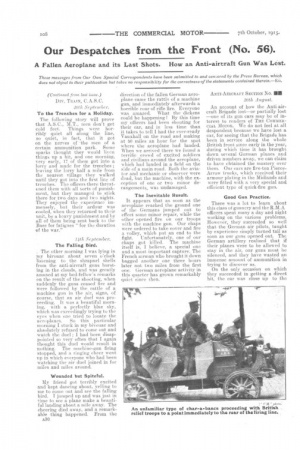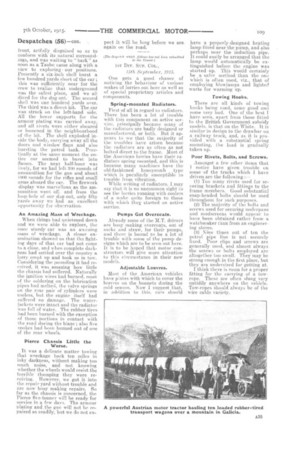Our Despatches from the Front (No. 56).
Page 8

Page 9

If you've noticed an error in this article please click here to report it so we can fix it.
A Fallen Aeroplane and its Last Shots. How an Anti.-airtraft Gun Was Lost.
These messages from Our Own .Special Correspondents have been submitted to and censored by the Press Bureau, which does not object to their publication but takes no responsibility for the correctness of the statements contained therein.—ED.
(Continued .fronz last issue.)
Div. TRAIN, C.A. S. C. 201h September.
To the Trenches for a Holiday.
The following story will prove that A.S.C., M.T., men don't get Cold feet. Things were horribly quiet all along the line, so quiet, in fact, that it got on the nerves of the men of a certain ammunition park. Some sparks thought they would liven things up a bit, and one morning, very early, 17 of them got. into a lorry and made for the trenches ; braving the lorry half a mile from the nearest village they walked until they got into the first line of trenches. The 'officers there threatened them with all sorts of punishment., but they managed to stick there for two days and two nights. They enjoyed the experience immensely, but their ardour was cooled, when they returned to their unit, by a heavy punishment and by all of them being sent back to the Base for fatigues "for the duration of the war."
14th September.
The Falling Bird.
The other morning I was lying in triv bivouac about seven o'cluck listening to the shrapnel shells from the anti-aircraft guns bursting in the clouds, and was greatly amused at my bed-fellow's remarks on the result of the shooting, when suddenly the guns ceased fire and were followed by the rattle of a -machine gun in the air, signs, of course, that an air duel was proceeding. It was a beautiful morning, with a perfectly blue sky, which as exceedingly trying to the eyes when one tried to locate the aeroplanes. So this particular Morning I stuck in my bivouac and absolutely refused to come out and watch the duel ; I had been disappointed so very often that I again thought this duel would result in nothing. The machine-gun firing stopped, and a ringing cheer went up in which everyone who had been watching the air duel joined in for miles and miles around.
Wounded but Spiteful.
My friend got terribly excited and kept dancing about, yelling to me to come out and see the falling bird. T jumped up and was just in time to see a plane make a beautiful landing about a mile away. The cheering died away, and a remarkable -thing happened. From the A30.
direction of the fallen German aeroplane came the rattle of a machine gun, and immediately afterwards a horrible roar of rifle fire. Everyone was amazed. What the dickens could be happening ? By this time my officers had been shouting for their car, and in less time than it takes to tell I had the ever-ready Vauxhall on the road and making at 50 miles an hour for the spot where the aeroplane had landed. When we arrived there we found a terrific crowd of excited soldiers and civilians around the aeroplane, which had landed in a field on the side of a main road. Both the aviator and mechanic or observer were dead, but the machine, with the exception of one or two minor derangements, was undamaged.
The Inevitable Result.
It appears that as soon as the aeroplane reached the ground one of the Germans jumped out to effect some minor repair, while the other opened fire on our troops with the machine, gun. Our chaps were ordered to take cover and fire a volley, which put an end to the fight. Unfortunately, one of our chaps got killed. The machine itself is, I believe, a special one and a most important capture. The French airman who brought it down bagged another one three hours later not two miles from the first one. German aeroplane activity in this quarter has grown remarkably quiet since then. ANTI-AIRCRAFT SECTION No. MI 20th August.
An account of how the Anti-aircraft Brigade lost—or partially lost —one of its gun cars may be of interest to readers of THE COMMERCIAL MOTOR. We do not feel at all despondent because we have lost a car, for seeing that the Brigade has been in service along the whole British front since early in the year, during which time it has brought down several German planes and driven numbers away, we can claim to have obtained the mastery over them. Our cars are five-ton PierceArrow trucks, which received their armour plating in the Midlands and were fitted with a very special and efficient type of quick-fire gun.
Good Gun Practice.
There was a lot to learn about this class of gunnery and the R.M.A officers spent many a day and night working on the various problems. However' they succeeded so well that the German air pilots, taught by experience simply turned tail as soon as our guns opened out. The German artillery realized that if their planes were to be allowed to stay in the air, our guns must be silenced, and they have wasted an immense amount of ammunition in trying to discover us.
On the only occasion on which they succeeded in getting a direct hit, the car was close up to .the. front, artfully disguised so as to conform with its natural surroundings, and was waiting to" bark" as soon as a Taube came along with a, view to exploring our positions. Presently a six-inch -shell burst a few hundred yards short of the car ; this was sufficiently near for the crew to realize that underground was the safest place, and we all dived for the dug-out. The second shell was one hundred yards over. The third was a direct hit. The car was struck on the left-hand side. All the lower supports for the armour plating was carried away, and all rivets were either sheared or loosened in the neighbourhood of the hit. The shell exploded inside the body, carrying away all the doors and window flaps and also bursting the petrol tank. Practically at the same moment the entire car seemed to burst into flames. The next half-hour was lively, for we had left 300 rounds of ammunition for the gun and about 1000 rounds for the rifles and small arms aboard the car. The firework display was marvellous as the ammunition went. off. and from the loop-hole of our dug-out, only fifty yards away we had an excellent opportunity for observation
An Amazing Mass of Wreckage.
When things had quietened down and we were able to explore, the once sturdy car was an amazing mass of wreckage. A closer examination showed us that the fighting days of that car had not come to a close, and when complete darkness had settled over the country a lorry crept up and took us in tow. Considering the pounding it had received, it was amazing how little the chassis had suffered. Naturally the ignition wires had burned, most of the soldering on the lubrication pipes had melted, the valve springs on the rear pair of cylinders were useless, but the engine itself had suffered no damage. The waterjackets were intact and the radiator was full of water.. The rubber tires had been burned with the exception of those portions in contact with the road during the blaze ; also five spokes had been burned out of one of the roar wheels, Pierce Chassis Little the Worse.
It was a delicate matter towing that wreckage back ten miles in inky darkness, without making too much noise, and not knowing whether the wheels would resist the terriblethumping they werereceiving. However, we got it into the repair yard without trouble and are now busy making repairs. So far as the chassis is concerned, the Pierce five-tonner will he ready for service in a• few days. The armour plating and,the gun will not be repaired so readily, but we do not ex
pect it will be long before we are. again on the road.
(The de.sperieh lees 011ows Sae not km submitted to she Cenmsrj
1ST DIV. SUP. COL.,
15th September, 1915.
One gets a good chance of noticing the behaviour of various makes of lorries out here as well as of special proprietary articles and components.
Spring-mounted Radiators.
First of all in regard to radiators. There has been a lot of trouble with this component on active service, principally . because many of the radiators are badly designed or manufactured, or both. But it appears to me that the majority of the troubles have arisen because the radiators are as often as not bolted direct to the frame. Most of the American lorries have their radiators -spring mounted, and this is because many machines have the old-fashioned honeycomb type which is peculiarly susceptible to trouble from vibration.
-While writing of radiators,! may say that it is no uncommon sight to see the lorries running with coolers of a make quite foreign to those with which they started on active service.
Pumps Get Overcoats.
Already some of the M.T. drivers are busy making overcoats, out of sacks and straw, for their pumps, and there is bound to be a lot of trouble with some of the pump designs which are to he seen out here. It is to be hoped that motor constructors will give more attention to this circumstance in their new models.
Adjustable Louvres.
Most of the American vehicles have plates with which to cover the louvres on the bonnets during the cold season. Now I suggest that, in addition to this, cars should have a properly-designed heating lamp fitted near the pump, and also perhaps near the induction pipe. It could easily be arranged that the lamp would automatically be extinguished before the engine was started •uti. This would certainly be a safer method than the one which is often ased, viz., that of employing blowlamps and lighted waste for warming up.
rowing Hoolis.
There are all kinds of • towing hooks being used, Some good and some very bad. One of the best have seen, apart from those fitted to the British Government subsidy models, is that on the White. It is similar in design to the drawbar on a railway truck, and, as it is provided with a substantial spring mounting, the load is gradually taken up.
Poor Rivets, Bolts, and Screws.
Amongst a few other items that notice have given trouble on some of the trucks which I have driven are the following
(1) Too many rivets used for securing brackets and fittings to the frame members. Good substantial snap-headed bolts should be used throughout for such purposes.
(a) The majority of the bolts and screws used for securing underpans and mudsereens would appear to have been obtained rather from a watchmaker than from an engineering stores.
(3) Nine times out of ten the petrol pipe line is not securely fixed. Poor clips and screws are generally used, and almost always the screws or bolts employed are altogethex too small. They may be strong enough in the first place, but they are undersized for getting at. I think there is room for a proper fitting for the carrying of a towrope. These are often slung very untidily anywhere on the vehicle. Tow-ropes should always. be of the wire cable variety.




















